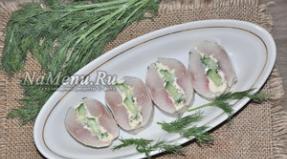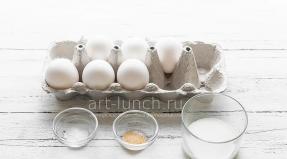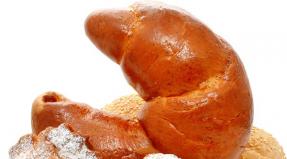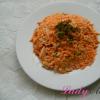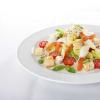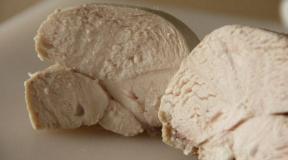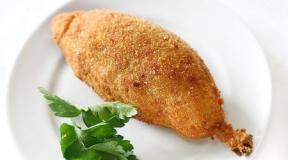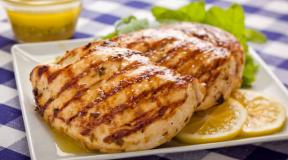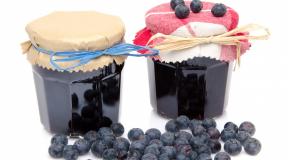A real Olivier recipe available to every housewife. Authentic Olivier salad
Almost every Russian loves the usual Olivier salad, made from such inexpensive ingredients as green peas, doctor's sausage, boiled potatoes, carrots, chicken eggs and pickled cucumbers.
In fact, a century ago, this dish was cooked differently, with more expensive ingredients. It was considered a real delicacy and was distinguished by its exquisite, excellent taste.
The history of the creation of salad "Olivier"
The recipe for this delicious snack was invented in the second half of the 19th century by Lucien Olivier, a famous French chef. He settled in Moscow and in 1860 opened a first-class restaurant called the Hermitage. It is believed that it was Lucien who came up with a great appetizer that has become a real work of art.

Her taste struck with its sophistication, harmony, and therefore pleased all visitors to the Hermitage restaurant. Subsequently, many cooks tried to repeat the recipe for the old Olivier salad. But they, not knowing all the secret ingredients, and most importantly, the method of preparing the incomparable white sauce with mustard, were defeated. You could taste the wonderful Olivier salad, a real French one, only in the famous restaurant of Lucien.
How did Lucien Olivier himself prepare the salad?
The French chef jealously kept the recipe for his signature dish secret. Originally, Olivier served it in the following way. Boiled fillets of partridges and hazel grouses were laid out in layers of jelly made from broth and placed in the center of the dish. Boiled crayfish necks and pieces of tongue were laid out around. All this "beauty" was poured with a piquant, slightly spicy sauce (homemade mayonnaise). The dish was decorated with a composition of boiled potatoes, quail eggs and gherkins.

Once the cook noticed that the restaurant visitors mixed all the ingredients with a spoon, breaking the original "design", and then ate the resulting mass with appetite. So the recipe for the old Olivier salad has changed. Lucien began to serve the dish, mixing all the ingredients beforehand and generously flavoring them with Provencal sauce.
Recipe for an old salad "Olivier": the necessary ingredients
There are many variations of this dish. Modern salad "Olivier" is otherwise called "Russian". Modified for real Russian realities, the salad has lost its sophistication and has become a very common snack, the taste of which is familiar to everyone since childhood. Partridge and hazel grouse meat was replaced with inexpensive boiled sausage. Cancer necks, veal caviar were completely excluded from the recipe. Instead, they began to add boiled carrots and canned peas. Of course, the modern modification is tasty, but somewhat "pall". Therefore, we will tell you how to make a chic appetizer using the recipe for the old Olivier salad.

So, to prepare this delicious dish, you will need the following ingredients:
- veal tongue - 1 pc.;
- three hazel grouse;
- black pressed caviar - 80-100 g;
- potatoes 4 pcs.;
- lettuce leaves - 200 g;
- boiled crayfish - 30 pcs.;
- pickled cucumbers (gherkins) 180-200 g;
- fresh cucumbers - 2 pcs.;
- capers - 100 g;
- quail eggs - 6 pcs.
The following components are required for:
- white wine vinegar - 1 tbsp. l.;
- egg yolk - 2 pcs.;
- olive oil - 6 tbsp. l.;
- spicy mustard - 1 tsp;
- a pinch of ground pepper;
- salt;
- garlic powder.
Salad "Olivier" (real recipe): cooking technology

To begin with, let's deal with the bird and veal tongue. We will wash and, if necessary, gut the carcasses of hazel grouse. By the way, if you do not have the opportunity to purchase this game, you can replace it with quails. After processing, the bird is placed in a pot of water and boiled for one and a half hours. Do not forget to add onion head and salt to taste to the broth.
While the hazel grouses are preparing, let's take care of the tongue. We wash it and boil it for two hours, adding carrots, onions, salt and spices to the broth. After the allotted time, we will get hazel grouses and veal tongue out of the water. Cool the meat and clean it. We remove the skin and bones from the bird, leaving only the fillet. Cut the tongue into small pieces. Now cook the crayfish until cooked, pull out of the water, cool and clean. Next in line are potatoes and eggs. Boil them, cool and clean.
We cut all the ingredients and make dressing
We will tell you further how to cook a real Olivier salad. We select a deep bowl for snacks. We tear and put lettuce leaves in it. We clean fresh cucumbers from the skin and cut into cubes. Grind pickled gherkins and capers. Put everything in a salad bowl. There we also place the prepared veal tongue and the meat of hazel grouse cut into pieces. Chop the quail eggs into small pieces.
We leave our dish alone for now and make mayonnaise sauce. Raw yolks, mustard and salt are mixed with a whisk. Pour olive oil into these ingredients in a thin stream, kneading the mass thoroughly until it thickens. Add vinegar, ground pepper and garlic powder to the sauce. Everything, mayonnaise is ready.

We dress our Olivier salad with sauce. This recipe involves decorating the dish with black pressed caviar and crayfish tails. That's all, a delicious snack is ready. Now you know how to cook a real Olivier salad. As you can see, it's not difficult, the main thing is to get all the necessary ingredients and make homemade mayonnaise sauce. Bon Appetit!
Another version of Olivier salad for your holiday table
If you want to pamper your family with a gourmet dish, prepare the Olivier salad. This is the real French recipe. To create this culinary masterpiece, you will need the following products:
- quail eggs - 6 pcs.;
- potatoes - 3-4 pieces;
- quails - 3 pcs.;
- pickled cucumbers - 2-3 pcs.;
- fresh cucumbers - 2 pcs.;
- veal tongue - 200 g;
- carrots - 2 pcs.;
- pickled capers - 100 g;
- champignons - 100 g;
- canned cancer necks - 50 g;
- - 30 g;
- olives - 50 g;
- chives 20 g
The recipe for the old Olivier salad involves the use of a special one for the preparation of which you will need olive oil - 100 ml, egg yolks - 3 pcs., wine vinegar - 2 tsp. Also needed are lemon juice - 2 tsp, Dijon mustard - 1 tsp, salt and pepper to taste.
The process of preparing an excellent snack

The old recipe for "Olivier" is as follows: boil the potatoes in their skins and carrots, cool, peel and then cut the vegetables into cubes. Boil the eggs in boiling water for 5 minutes, cool and peel. Cut the yolks and whites from three eggs into large pieces, and cut the remaining whites in half (they will be needed to decorate the salad). Wash the quail carcasses, wipe with a paper towel, coat with vegetable oil, pepper and salt. Place the bird in the pan and fry it over high heat for 7 minutes until golden brown. Then place the quails for 15-20 minutes in an oven preheated to 180 ° C. After baking, cool the bird, separate the meat from the skin and bones, cut it into cubes.
Serve "Olivier" to the table
Wash the veal tongue and boil for 1.5-2 hours in salted water. Then let it cool and cut into small pieces. Chop pickled and fresh cucumbers (without skin) and olives. Canned cancer necks cut into large pieces, you can into two parts. Lightly toast the capers in a dry frying pan. Place all ingredients in a deep container and mix gently.
Everything, our Olivier salad is almost ready. An old recipe involves the preparation of the original mayonnaise dressing. In a bowl, beat the egg yolks with a whisk, adding salt, mustard, pepper to them. Pour in the olive oil while continuing to whisk. Add lemon juice and wine vinegar there. Pour dressed sauce over salad. Serve the dish garnished with egg whites with caviar, chives, champignons, lightly fried in a pan, and crayfish tails. Bon Appetit!
For the New Year holidays, we always prepare our favorite Olivier, it has long become a classic, without which we cannot imagine the New Year. But not everyone knows that the Olivier salad (the real French recipe of which we will consider) was originally not a salad and had a very unusual composition of ingredients. It is not known how the creator himself prepared the dish, the chef did not reveal this secret to anyone, but the recipe was preserved, which was told to the world by one of the visitors to his restaurant.
The original dish is very far from the usual cooking option for us. Few people know that initially Olivier was not rifled. All of its ingredients were served whole, beautifully laid out on a plate.
The idea to cut products did not come to the creator of the dish immediately. Only after he began to notice that the visitors of his restaurant cut whole pieces of meat and mix them together, eating with appetite in this form, the idea ripened - to serve the dish in the form of a salad.
You can find more details on the history of the origin of the salad and the changing recipe for Olivier from different years in our article.
As you can see, preparing your favorite Olivier salad is not so difficult. However, the real French recipe for its preparation is really impressive, it is not surprising that the dish was considered crown on the menu of the chef himself.
If you also want to make a salad at your place the “king of the feast”, thereby surprising your relatives with an extraordinary delicacy, then it is worth spending money and time on cooking. Happy cooking and delicious food.
Bon Appetit!
by Notes of the Wild MistressIf not in every first, then certainly in every second house there will be Olivier salad on the festive table on New Year's Eve. The real classic Olivier salad recipe could not be completely restored, however, and today we know the very ingredients from which the Moscow restaurateur of French origin Lucien Olivier made his famous salad.
How did Olivier salad come about?
Having once prepared a dish called “Game Mayonnaise”, the restaurateur served it to the table and began to observe whether his guests would like it.
By the way, “Game Mayonnaise” is a complex dish consisting of many ingredients. It included partridge and hazel grouse fillets, boiled tongue and crayfish necks, poured with mayonnaise sauce, which Lucien Olivier also came up with. The meat was covered with pieces of jelly, and in the center of the dish there was a slide made of boiled potatoes with decorations from small spicy cucumbers and hard-boiled eggs. Moreover, Olivier laid out a decorated potato slide not for food, but for decorating the dish.

Imagine his amazement and even indignation when he saw that inexperienced visitors were mixing all the ingredients of the "game mayonnaise" with a spoon and only then with great pleasure they consumed this "barbaric" mixture. And then Olivier next time himself mixed all the ingredients and served a new dish to the table, moreover, he did it, wanting, as it were, to stab indiscriminate eaters, but the effect was quite the opposite. The new salad immediately became so popular that visitors rushed to Olivier's restaurant just to taste the new unusual dish.
The secrets of the classic recipe for a real Olivier salad
After the death of the famous restaurateur, no one could repeat the classic recipe for a real Olivier salad, and only over time, by 1904, with the help of the restaurant's regulars, almost all the ingredients were restored.
But, nevertheless, it was still not the same salad.
The fact is that Olivier took with him to the grave some unique additives to the sauce, which he always kept in strict confidence. It is known that a real Olivier salad according to the classic recipe was dressed with Provence sauce, which was prepared exclusively on French vinegar, Provencal olive oil with the addition of the freshest egg yolks. But what else was included in Lucien Olivier's recipe still remains a mystery.

Authentic Olivier Salad Ingredients
So what did the real Olivier salad consist of, the classic recipe of which was restored in 1904?
The recipe was supposed to take:
Meat from two boiled hazel grouse
One boiled veal tongue
25 boiled crayfish, 1 large boiled lobster or 1 can of lobster
100 grams of black pressed caviar
1 cup lanspic (thick bouillon jelly, diced)
200 grams of fresh lettuce
250 grams of pickled cucumbers (pickles)
250 grams of kabul sauce
Two fresh cucumbers
100 grams of capers
Five hard boiled eggs.
It is unlikely that you will cook a real Olivier salad according to the classic recipe, but, you see, it is interesting to find out what kind of gourmets the regulars of famous Russian restaurants were. Although, the most delicious and real, the classic Olivier salad is the one that you cook with enthusiasm, with love and imagination!
Chapter:
Salads
See the sections and for many recipes for holiday salads.
All the richness of salads and wonderful dishes from different peoples of the world, see the relevant sections
Three world famous salads
Part 1 -
Part 2 -
Part 3 - real Russian salad "Olivier" in the history of Russia. History, recipe of Lucien Olivier, recipes of the Soviet "olivier". About the famous Moscow chef and French restaurateur Lucien Olivier. From the history of Moscow restaurants.
Freight potato.
Part 3
Russian national salad
"Olivier salad"
in the history of Russia
In France and Turkey, various simplified versions of this salad, which appeared among the emigrants after 1917, are still called "Russian salad" and are very popular. Later, these recipes laid the foundation for the famous "Soviet Olivier".
But only the original salad recipe, developed in the second half of the 19th century by a Moscow chef-restaurateur, a Frenchman by origin, Lucien Olivier, is truly magnificent. He was from the famous Olivier culinary family in France. At the beginning of the 19th century, a culinary specialist from this family also invented a recipe for Provence mayonnaise, adding 4-5% mustard and some secret spices to the classic mayonnaise for spiciness, which made the mayonnaise amazing in taste. (See page for more on this). It was the special mayonnaise that distinguished the Olivier salad from all the others.
In addition to a delicious salad, Russians have enriched French cuisine and the word bistro, descended from the Russian "quickly".
When the Russian troops who defeated Napoleon reached France, drunken Russian Cossacks in the occupied territory, bursting into various eateries, yelled "Quickly! Quickly!", banging his fists on the counter and hurrying the already frightened French tavern-keepers.
But the then Russian military, unlike our time, were not constrained in monetary allowance, therefore they never stooped to robberies, in Russian widely demonstrating their generosity.
Catching that the Russian soldiers not only loudly demand, but also pay well, and often “forget” to take change, the owners of the establishments soon began to hang signboards written in the French style that were enticing for the Russian occupiers: BISTRO.
It is curious that in those days, many Russian military spoke excellent French. This greatly facilitated front-line reconnaissance during the Patriotic War of 1812. Officers-nobles from different combat detachments simply changed into French uniforms and, having penetrated into the location of the enemy, sat down by the fires, conducting free conversations on various topics with unsuspecting French soldiers and officers.
During the Great Patriotic War of 1941-45. this was already simply impossible due to ignorance of the language.
The history of the creation of a real salad "Olivier"
For many decades, Muscovites' festive feast - from a rich restaurant table to a student party - has always included a traditional dish with a French aristocratic name - Olivier salad. Each of us has eaten it more than once. But is this "Olivier"? Let's see history.
This salad was invented in the 1860s by a French chef. Lucien Olivier(1838-1883) - Moscow restaurateur, owner of the Hermitage tavern on Trubnaya Square. The building of the tavern has been preserved, this is house 14 on Petrovsky Boulevard, corner of Neglinnaya, now it houses a publishing house and a theater.
In no case should you use it for dressing from the store - it will irreparably spoil the delicate taste of this salad!
Cooking.
1) Ryabchikov briefly in a layer of hot oil 1-2 cm thick over intense heat until a slightly fried crust forms on all sides (but not until cooked!). Then transfer to boiling water or broth (chicken or beef) and add about 150 ml of Madeira per 850 ml of broth, 10-20 mushrooms, 10-20 pitted olives and cook under a tightly closed lid over low heat for 20-30 minutes, until the meat will not easily separate from the bones. Salt lightly 3-5 minutes before the end of cooking.
Place the saucepan with the contents in cold water to cool slightly. (If you start separating the meat of hazel grouse from the bones in a too hot state, the meat will dry out during the cutting process due to excessive evaporation of moisture. But you don’t have to keep ready-made hazel grouses in the broth for a long time so that they don’t get wet. And if you cool to a cold state, then the separation of meat from the bones will be difficult.) Wrap the separated meat in a film or foil and place in the refrigerator. Use mushrooms and the resulting broth for other dishes.
If necessary, two hazel grouses can be replaced with one medium-sized chicken, which should be cut lengthwise into two parts before spinning. Boil the chicken for 30-40 minutes.
2) When buying a tongue, make sure it is free of fat, sublingual muscle tissue, lymph nodes, larynx, hyoid bone, mucus, and blood. If it is beef tongue of an adult, then half of the tongue will be enough.
Rinse tongue thoroughly with water before cooking. Put the tongue in cold water, bring to a boil and cook over low heat (so that it floats “over the bulge”) with the lid tightly closed for 2-4 hours, depending on the age of the individual. 30 minutes before the end of cooking, add sliced carrots, parsley root, onions and half a bay leaf. Salt a little 10 minutes before the end of cooking.
After readiness, immediately transfer the tongue from the broth to a bowl of cold water for 20-30 seconds, put it on a plate and immediately remove the skin from it. If your tongue starts to burn your fingers while cleaning, dip it briefly in cold water again and continue cleaning. Then put the peeled tongue back into the broth, quickly bring to a boil, turn off the heat and put the covered pan to cool in cold water. Remove the tongue from the cooled broth, wrap it in a film or foil and place in the refrigerator.
3) Pressed caviar (but not black granular!) Cut into small cubes and put in a salad along with other products.
ABOUT PYUSE CAVIAR. Pressed caviar is much more difficult to produce, but also tastier than grained caviar (it has a delicate oily taste and a very delicate aroma - see). When preparing pressed caviar, the mass of the original fresh caviar decreases significantly more than when preparing granular caviar, but this ensures not only an excellent taste, but also good preservation in the absence of preservatives that are simply necessary in granular caviar (in fact, a product that cannot be stored at all!) going on sale in the trading network. Oddly enough, in the Soviet Union it was cheaper and therefore was perceived by the culinary illiterate population as “second-class” caviar. The complexity and laboriousness of the preparation technology, a significant decrease in the mass of the product at the exit led to the virtual disappearance of pressed caviar from the shelves of modern Russian stores.
To make pressed caviar, after catching fish, caviar is immediately salted in ovaries, and then laid out in splints (small troughs) and slightly dried (winded). After that, the caviar is freed from the eggs, cleaned of all veins and mucus and crushed in vats with pushers, which is why the eggs become dense, flat and acquire a special taste that arises from the combination of slightly dried (fermented) eggs with fresher, soaked, saturated brackish sturgeon fat.
4) Lettuce leaves are thoroughly washed, dried with a towel and finely chopped just before laying them in the salad.
5)
Wash live crayfish with cold water (sleeping crayfish and lobsters are unsuitable for cooking), lower them upside down into a pot of boiling water, into which finely chopped:
- parsley 25 g,
- carrots 25 g,
- fresh tarragon 10 g or a little dry,
- onion 25 g,
- dill 30-40 g,
- 1 bay leaf,
- salt 50 g,
- a little allspice.
(i.e. boiling is carried out in the so-called)
Quickly bring to a boil again, reduce the heat, cover the pan with a lid and cook the crayfish for 10 minutes from the moment of boiling.
Turn off the fire without opening the lid, let it brew. Remove ready-made crayfish from the broth 5-10 minutes after the end of cooking, cool and remove the meat from the crayfish necks and claws.
When boiling lobster (lobster), everything is the same, but cooking continues for 40 minutes, then leave under the lid for 10 minutes.
Wrap the resulting meat tightly in a film and place in the refrigerator or immediately cut and lay in a salad.
If using canned lobster, drain liquid and use finely chopped meat in salad.
The meat of crayfish and lobsters is very tender, therefore it is put into the salad last, together with eggs, minced caviar and fresh cucumbers.
6) Finely chop the pickles before adding them to the salad.
7)
Half a can of canned soy without tomato - drain the liquid, grind into a paste and add to taste (but a little!) South or Moscow sauce, or soy sauce. If soy with tomato - put in a colander, rinse with boiling water, cool, grind, add sauce and put in a salad.
To taste, soy can not be kneaded and put in the salad as a whole.
8) Fresh cucumbers must be peeled and finely chopped.
9) Use half a glass of ready-made canned pickled capers, after draining the liquid.
10) Put the eggs in cold water, bring to a boil quickly and boil for 7-8 minutes depending on the size. Don't overcook the eggs! Then immediately fill with cold water and let cool. If the eggs are not very large, then you may need to take 6-8 eggs.
Finely chop all the listed ingredients, put them together in a bowl and mix gently, seasoning with mayonnaise.
Some products can be used incompletely, leaving a little to decorate the salad on top.
Serve immediately.
To taste, you can use no more spicy for salad dressing - this will provide a delicate, natural and refined taste of the salad (which was chosen when ordering by the regulars of the restaurant Lucien Olivier). When choosing, the cook should take into account the amount of alcohol previously drunk by the guests - the more drunk, the spicier the salad (up to a small addition of ready-made mustard and tarragon). Children are dressed with classic mayonnaise sauce.
* * * * * * * * * * * *
After the seizure of power in 1917 by the Bolsheviks in Soviet Russia, there was no time for culinary delights. Everyone was obliged to deal only with the World Revolution and serving the Bolsheviks. Those who did not serve were deprived of food cards, which meant inevitable starvation.
The defeat in the war with Germany, the fratricidal civil war and the actions of the Bolsheviks in those years, the country was ravaged to the ground.
On the streets there are huge numbers of homeless children, war cripples, refugee families with children, homeless vagrants...
The people were starving, many died of hunger and cold ...
At that time, the great Russian poet of the 20th century, Vladimir Mayakovsky, writes:
Not home, not for soup,
and visit your beloved
I carry two carrots
for the green tail.
I gave a lot of sweets and bouquets,
but more than all the expensive gifts
I remember this precious carrot
and half a log of birch firewood.
About what was happening then, see the article about the fate and work of the author of the famous Russian culinary recipe chosen at that time by the "king of Russian poets" "PINEAPPLES IN CHAMPAGNE" .
Ahead of the Soviet people were still waiting for serious wars (in Spain, in the Far East, in Finland, the Great Patriotic War, again in the Far East), the death of tens of millions of people in the war and in Stalin's camps, terrible military devastation, the restoration of the economy from the ruins, the strain of all forces countries in the creation of nuclear missile weapons by the will of Stalin and other historical adventures.
It seemed that the very word "Olivier" was completely forgotten.
* * * * * * * * * * * *
A new history of salad "Olivier"
Soviet salad "Olivier",
immigrant
However, having ended its history so sadly, first in its own restaurant, and then throughout the country, Olivier salad returned to the USSR from emigration in the 1950s and began to win a place on the tables of “advanced elite” Muscovites (including Moscow restaurant menus) , and soon all Soviet people.
The simplified Olivier recipe arose among the impoverished Russian emigration that fled after the 1917 revolution, as a triumph of the ingenuity of emigrant housewives who wanted, as far as possible, to imitate the old fashionable recipes.
This uncomplicated "emigrant" Olivier salad returned to the USSR from France after the 2nd World War as a result of expanding diplomatic contacts with Europe, and especially massively after the 6th World Festival of Youth and Students in Moscow in 1957.
The emigrant version of the salad was quickly creatively adapted by Soviet housewives and restaurant chefs to the conditions of the then Soviet reality, in which not only lobsters, familiar to France, but even capers were absent.
Green peas were sold only in "orders", so they were stockpiled specifically for Olivier. The “difficulty of obtaining” canned peas in the conditions of the economy of “developed socialism” elevated it to the rank of a “prestigious” product, which not only turned the entire dish into which it was included into a “special”, “festive”, but also in a sense increased the status of others. its ingredients are the "neighbors" of peas in the Olivier salad.
Mayonnaise was in a terrible shortage and was produced only in large cities.
Therefore, even the very words “mayonnaise-provencal” and “Olivier salad” set the Soviet people in a special festive, almost foreign way and attracted attention in contrast with the names of most other familiar dishes.
In the 1960s, the Soviet recipe was radically different from both the famous restaurant original of the 19th century and the emigre version, which only contributed to the popular love of Russians for this salad, gradually adapted to the tastes of people and to the availability of common and affordable products. Only mayonnaise remained from Lucien Olivier's original recipe.
All sorts of lobsters, hazel grouse, beef tongue were then replaced with boiled sausages and sausages (by the way, then they were quite full-fledged). Soy, which was not very common at that time and, as it turned out later, quite harmful in nutrition, was replaced by healthy green peas. At that time, Soviet industrial mayonnaise was quite consistent with the proper recipe.
The salad was tasty and nutritious. But in restaurant versions even then the sausage was replaced with boiled beef or chicken.
Since the 1960s in the USSR, and now in post-Soviet Russia, no festive table is unthinkable without the Olivier salad, the recipe of which is very arbitrary, based on the possibilities.
Only now, as well as the current falsified industrial "mayonnaise" have recently become simply unacceptable in human nutrition. Therefore, now successfully use any boiled meat, chicken and, which is very simple, in recipes. But boiled potatoes in their skins and canned peas still remain the same.
The components of the simplest Olivier salad are boiled potatoes (even better for a salad - potatoes baked in the oven, or fret potatoes boiled in a saturated salt solution - see below at the end of the page) and boiled sausage, diced, canned green peas and industrial mayonnaise. Otherwise, this salad gives the hostess complete freedom of imagination. One lady, giving the recipe, said: "I also put everything that is in the house."
Salad "Olivier" has become the "calling card" of the festive table, it is mandatory, even if in addition to it there were some more expensive or exotic pickles. The significance of "Olivier" for the festive meal was emphasized primarily by the practices of serving and serving it, which were of a completely ritualized nature. He was always in the middle of the table. The main. It is customary to serve "Olivier" in salad bowls "smartly-festively-glass-porcelain" - whoever has what. For some, a crystal vase was obligatory, as a sign of luxury and prestige.
The unwritten convention to start with "Olivier" ensured the inclusion, or "pass", in the entire subsequent meal. It is significant that the late guests, regardless of what stage of development the feast managed to reach, were also served Olivier in the first place.
“Olivier”, in the minds of the audience, was mainly a festive dish, its eating was the watershed that finally separated everything “pre-holiday” from the actual holiday, allowed to distance - and collectively - from everyday life and further, putting aside any worldly care, plunge into another reality.
The latter was greatly facilitated by the fact that Olivier, as the very first dish on a festive plate, was also the first snack for drinking. Under the first toast, as a rule, Olivier went, the meal began with it. Because everything was there. For every taste! This is a good snack for a drink. You could drink and not get very drunk! It has been customary to use Olivier in this way since the time of Olivier's Hermitage Tavern.
The latest history of salad "Olivier"
The next band in the life of "Olivier" came in the 1990s. Some felt that they no longer enjoyed eating the Soviet Olivier, because it was too simple, it suddenly became “bored” and “tired”. In the hierarchy of post-Soviet cuisine, the Soviet “Olivier” was transferred to a lower position, he made room for other dishes, and became more ordinary.
To a large extent, this is due to the fact that Russian industrial sausages and mayonnaise, which are traditionally part of it, have now become simply inedible - the taste and nutritional value of the salad prepared with them does not correspond to what should be.
First, Olivier was replaced by salads with corn, then salads with shrimp and crab sticks, Korean and Japanese salads, Mexican and Spanish salads, and many others. It became correct and prestigious not to follow tradition, but to show "fantasy" and "artistry", and not everyone associated the good old "Olivier" with these concepts.
Of course, Olivier is not going to give up its positions just like that - after all, its main, “material” function, “nutrition”, has not disappeared anywhere, and people, including guests, still need to be fed.
Having adapted to the new capitalist Russian conditions, "Olivier" not only retains the old "clientele", but also successfully recruits a new one. Olivier is especially loved by children and young people.
True, for young people this dish is now devoid of that aura of festivity that is so memorable to older people. For them, this is not a festive element at all, and his French name no longer sounds with its former charm.
With the current availability of products, Olivier has become a simple and quick dish to prepare at the usual home table.
Only in Russia today, instead, you need to use various cut into pieces of meat and season it yourself (especially for feeding children). The popularity of such a completely full-fledged "Soviet Olivier" for both your family members and guests will increase significantly.
Recipes of the Soviet salad "Olivier"
The most common
proletarian salad recipe "Olivier"
Ingredients:
green peas (0.5 cans),
potatoes (2-3 pieces),
boiled sausage (100 g),
onion (1 onion),
mayonnaise,
chicken eggs (5 pieces).
COOKING:
Boil eggs and cut into small pieces, add green peas and finely chopped onion. Pour boiled and chopped potatoes in the same place, also make sausage. Season everything with mayonnaise and salt. Very simple and tasty salad. (If boiled chicken is taken instead of sausage, then this is the Stolichny restaurant salad, and if boiled beef, then the Moscow restaurant salad).
Salad "Olivier" with pickles
(student-style salad)
One serving of finely chopped:
half an egg,
half a cucumber
half a potato
a tablespoon of green peas
onion quarter,
sausages are a thin circle.
And everything is filled with mayonnaise.
Salad "Olivier" with pickled cucumbers
200 grams of boiled chicken or sausage, three potatoes, 3 eggs, a couple of pickled cucumbers, onions and peas to taste. Everything is finely crumbled and poured with mayonnaise.
More advanced Soviet recipe
Ingredients for 6-7 servings:
meat of 1 chicken breast or 200 g of boiled beef,
400 g potatoes, boiled in their skins,
2 medium pickled (or pickled) cucumbers,
1 cup canned green peas
1 medium onion, finely chopped
200 g mayonnaise,
2 hard-boiled eggs,
6 large black olives
8 sprigs of parsley.
COOKING:
Cut the boiled chicken, potatoes and peeled cucumbers into small cubes. Gently toss meat, potatoes, cucumbers, green peas and finely chopped onion. Add mayonnaise and salt to taste and stir without crushing the vegetables. Refrigerate before serving. If you want to make a vegetable salad, do not add chicken meat.
Salad "Olivier" with apples
Ingredients:
200 g boiled chicken,
6 potatoes
3 carrots
3 bulbs
2 pickled cucumbers,
1 apple
3 eggs,
glass of green peas
200 g mayonnaise
salt
ground pepper
greenery.
COOKING:
Boiled chicken meat, boiled carrots, potatoes, eggs, pickled cucumbers, sweet apples, peeled, finely chopped, add canned green peas, salt, pepper to taste. Mix everything carefully and put it in a salad bowl. Pour the salad with mayonnaise and garnish with sprigs of dill and parsley.
Salad "Olivier" with carrots
Ingredients for 4-6 servings:
potatoes - 5-6 small
carrots - 2-3 medium sized
sausage - 200-300 gr
green peas -1 bank
pickled cucumber - 2 pcs
mayonnaise - 3 tbsp. spoons
you can add a medium-sized onion and finely chopped parsley and dill.
Salad "Olivier" with cabbage
Ingredients:
2 cups shredded cabbage
2 medium carrots, peeled and cut into thin strips
1 large potato, boiled in their skins and cut into small cubes
1 medium apple, peeled and de-seeded, cut into small cubes
2 chopped hard-boiled eggs,
1 cup boiled fresh or frozen green peas
Refueling:
0.75 cup homemade "mayonnaise-like" sauce (see below)
0.5 cup sour cream
1 tablespoon Dijon mustard
2 tablespoons freshly squeezed lemon juice
0.5 teaspoon of sugar
salt and black ground pepper to taste.
COOKING:
Gently mix all the salad ingredients in a large bowl without mashing them, season generously with salt and pepper. In another bowl, mix the dressing thoroughly. Drizzle dressing over salad, cover and refrigerate until serving.
"Mayonnaise-like" homemade sauce
(For the preparation of a real classic mayonnaise sauce, see page )
Ingredients:
1 large egg, room temperature
1 steep yolk,
1 teaspoon Dijon mustard
2 tablespoons or more freshly squeezed lemon juice
a pinch of salt and ground white pepper to taste
1 glass of vegetable oil.
COOKING:
In a blender, mix the egg, yolk, mustard, lemon juice, salt and pepper and mix thoroughly until smooth. With the blender running, add the oil in a slow but steady stream. Taste and add spices if needed. (Makes about 1.33 cups) Transfer to a storage container and refrigerate. Can be stored up to 5 days.
The newspaper "Vechernyaya Moskva" in the New Year's issue of 1995 gave its recipe for "Olivier in the New Year's performance", recommending "to give the usual Olivier salad a New Year's tone":
New Year's salad "Olivier" from "Evening Moscow"
“Each housewife, of course, remembers that potatoes and eggs (the same amount), boiled meat, pickled (or better pickled) cucumbers, green peas, apples, mayonnaise are put in this salad. "Olivier" should be laid out on a round dish, and around - 12 circles of boiled potatoes. We cut the carrots into strips and put Roman numerals from 1 to XII on each potato circle. In the middle we will place a circle of cucumber or tomato, and from the onion we will make the hands of the clock.
But the Moscow newspaper "Moskovskaya Pravda" in its supplement "Night Rendezvous" (for aesthetic night owls) gives another recipe, more aristocratic:
Olivier salad from Moskovskaya Pravda
“You take six potatoes (medium size, everything will be medium size), three carrots, 2 onions, 1 - 2 small pickled (not salted) cucumbers, 1 apple, 200 grams of boiled chicken or other game (do not try to use boiled sausage according to the Soviet habit !), a glass of canned green peas, three eggs and 1-2 cans of mayonnaise. Of course, you boil potatoes, carrots, chicken and eggs, then cut them thinly and mix them gently. Before serving what happened, do not forget to decorate with thin slices of cucumbers, strips of chicken meat, on top - a sprig of parsley-dill, an apple slice.
But alas! - these are no longer Olivier salad recipes, this is our native Soviet-Russian myth about this salad.
Now in Russia, a mixture of any food that is at hand and diced, generously seasoned with a surrogate store, people call salad "Olivier".
Muscovites and now
honor the memory of Olivier - man and lettuce

In December 2006, at the Vvedensky (former German) cemetery of the capital (now it is the 12th section of the cemetery), Moscow restaurateurs laid wreaths and commemorated the legendary inventor of salad, Lucien Olivier, with a kind word.
In the 60s of the XIX century, he owned the Hermitage restaurant and was one of the founders of modern Russian cuisine. Later, already in the USSR, many of his developments formed the basis of Soviet cooking (see the famous "Culinary" and "The Book of Tasty and Healthy Food" of the "Stalinist" publications).
No one knows the exact date of the invention of the famous salad by the French restaurateur. Just like the exact recipe for Olivier, which was a specialty of the expensive Moscow tavern "Hermitage" on Trubnaya Square. Now there is the Theater of the Modern Play with a very cheap cafe, the student menu of which in 2006 included (and maybe still does - check for yourself), for example, a dish called "What's left of yesterday" for 5 rubles.
It is known that Lucien Olivier died at the age of 45 in 1883, and his famous dish, which has changed under the pressure of historical eras and culinary ingenuity, is now called "Russian salad" all over the world. Over the course of a century, the ingredients of the salad have completely changed: the dish has become a real hallmark of Russian cuisine, it is prepared both in expensive establishments and for home feasts.
In Soviet times, all catering establishments set an allowable margin, - says Igor Bukharov, President of the Federation of Restaurateurs and Hoteliers of Russia. - The restaurant mark-up for signature dishes was the highest. And since Olivier salad is easy to prepare, almost every restaurant in Moscow made it their signature dish, adding something of their own. This is how the salads "Capital", "Moskovsky" and several others appeared.
Therefore, the argument about what to cook a real Soviet Olivier with - with chicken, beef or sausage - is meaningless. Strictly speaking, in our time, salad "Olivier" can be safely considered any set of ingredients, diced and seasoned with Provencal mayonnaise. That is why the history of the main holiday dish of the country is indicative: in Russia, few people are interested in the history of national cuisine.
Lucien Olivier took the recipe for his salad to the grave, and only in 1904 was the likeness of his creation recreated, - continues Igor Bukharov. - Even less is known about other dishes of national cuisine. Not everyone knows what a folk dish, like dumplings, has been eaten in Russia for no more than 130 years, and its name came from the name of the city of Perm [this is Bukharov's personal opinion, see - approx. supercook]. They don’t know that at the beginning of the 20th century in the Moscow region, in the oak forests near Troitsk, up to five tons of black truffles were collected per season, and they were searched not with pigs or dogs, as in Europe, but with tame cubs, which were then everywhere in abundance ...
Having laid wreaths and red carnations at the grave of the famous culinary specialist (one of the representatives of the restaurant business joked that carnations on black marble looked very revolutionary), the restaurateurs, who gathered to celebrate the centenary of the establishment of the Mutual Aid Society of Tavern Owners, remembered the main merit of Lucien Olivier. It was from the 60s of the XIX century, when Olivier amazed Moscow with his culinary delights, that the restaurant business in Russia began to flourish.
Culinary recipes of Lucien Olivier, obtained by other restaurateurs by bribing or poaching chefs, were widely used in many expensive establishments and even published in newspapers.
Many recipes of the famous Frenchman are still used in the practice of restaurants and cafes, although often in a very simplified form.
FROM MOSCOW RESTAURANT HISTORY
Although unlike France, Germany, Italy, Great Britain, Japan and many others. other countries, Russia cannot boast of an abundance of its legendary restaurants, but they were.
Of course, most of the famous restaurants of Tsarist Russia were located in its capital - St. Petersburg. Many of them bore the names of the capitals of European states. Like, for example, "Paris" or "Vienna" - the second home for a whole galaxy of Russian actors, writers and poets - Chaliapin, Kuprin, Averchenko, Blok, Severyanin, Fofanov, Gorodetsky and many other of our famous compatriots.
You can also recall many legendary establishments of the northern Russian capital from the poem of the poet Nikolai Agnivtsev “Old Restaurant Petersburg: from Capernaum to a Restaurant”:
"Kyuba", "Contan", "Bear", "Donon",
Whose names are in champagne foam
Soared into the Neva sky
In its sparkling weave!
All of these restaurants were distinguished by luxuriously decorated interiors, exquisite and varied dishes, the widest selection of wines and, of course, extremely high prices. So their visit was an exceptional matter for the general public. But how many memories...
Interestingly, the owner of the St. Petersburg restaurant "Medved" was Alexei Sudakov, who began his career with the lowest position of a buffet boy - the lowest rank in the restaurant hierarchy of those years. Subsequently, Sudakov will become the owner of the famous Moscow Yar. By the way, this place still exists today. And approximately in the same form as a hundred years ago.
In the 19th century, the glory of two Moscow Frenchmen thundered in Moscow - restaurateurs Olivier and Yar.
The tavern "Yar" started on the Kuznetsky Most, where he visited Pushkin, who loved to "remember Yar's truffles." In the 1830s, Yar moved to the boundary of Petrovsky Park, to the last summer cottage (now Leningradsky Prospekt, 32). “Hey, coachman, drive to Yar” means exactly here.
The later owners ordered a new building of the restaurant to the architect Adolf Erichson, who lived on a neighboring site, the author of the "Sytin" house (now the Izvestia house) on Tverskaya.
It is hard to believe that the Sovetskaya Hotel with the Romany Gypsy Theater is the Yar, distorted by perestroika. But the theater here is not accidental: Yar was the center of gypsy culture in old Moscow. "What a choir sang at Yar ... Sokolov's guitar / It still rings in my ears."
The old building of the restaurant "Yar" on the Petersburg highway in the XIX century

The new building of the restaurant "Yar" on the Petersburg highway at the beginning of the 20th century 
The main entrance of the new building of the restaurant "Yar" at the beginning of the 20th century 
Hall in the new building of the Yar restaurant at the beginning of the 20th century 


Summer (White) hall of the Yar restaurant, 1910 
Yar (this is the modern restaurant of the Sovetskaya Hotel) is practically the only restaurant that has survived to this day from the “suburban” gypsy district of Moscow that thundered throughout Russia during the Silver Age.
Modern view of the summer terrace of the restaurant of the hotel "Sovetskaya"
(restaurant "Yar", as they call themselves now, 2008) 
Modern view of the restaurant hall of the hotel "Sovetskaya" 

| For the dishes of Moscow restaurants from the time of the Russian Empire, see the book of Vladimir Alekseevich Gilyarovsky (1853 - 1935), chapters, and others. Menu of the restaurant of the hotel "Sovetskaya" in 2008 |
||||||||||||||||||||||||||||||||||||||||||||||||||||||||||||||||||||||||||||||||||||||||||||||||||||||||||||||||||||||||||||||||||||||||||||||||||||||||||||||||||||||||||||||||||||||||||||||||||||||||||||||||||||||||||||||||||||||||||||||||||||||||||||||||||||||||||||||||||||||||||||||||||||||||||||||||||||||||||||||||||||||||||||||||||||||||||||||||||||||||||||||||||||
|
||||||||||||||||||||||||||||||||||||||||||||||||||||||||||||||||||||||||||||||||||||||||||||||||||||||||||||||||||||||||||||||||||||||||||||||||||||||||||||||||||||||||||||||||||||||||||||||||||||||||||||||||||||||||||||||||||||||||||||||||||||||||||||||||||||||||||||||||||||||||||||||||||||||||||||||||||||||||||||||||||||||||||||||||||||||||||||||||||||||||||||||||||||
Even more primitive menu of the restaurant "Yar" in 2011,
in which a very simplified culinary content, where almost all the past achievements of the great Russian cuisine are emasculated, the workers are trying to somehow make up for all sorts of sophisticated laudatory descriptions of dishes in an imported manner.
But this is no longer Russian cuisine, once famous for its special richness.
Cold snacks
25 gr. - 736 rubles.
50 gr. - 1056 rubles.
100 gr. - 1408 rubles.
Salads
[Note SC. Lucien Olivier's original salad never contained red caviar, nor did it contain grainy black caviar, but diced caviar. pressed black caviar(see above), which today in Russia, which has become impoverished and has lost its former food technologies, cannot be found in the daytime with fire.]
Hot snack
Soups
Seafood
Hot fish dishes
Hot meat dishes
Juicy veal tenderloin with champignons and porcini mushrooms with “Noilly Prat” sauce (yield in gr. 160/120/50) 1 568 rub.
* * * * * * * * * * * * * * * * * * * * *
Once upon a time, no less eminent establishments existed in the neighborhood of Yar. For example, the Apollo restaurant, located in Petrovsky Park. Shortly after the revolution of 1917, the institution, as was to be expected, was closed. In the mid-20s of the last century, the Aeromuseum was organized in its building, which later received the name of the House of Aviation and Cosmonautics (TsDAiK).
Another legend of the gypsy district is the Eldorado restaurant, located next to the Peterburgsky Trakt (the modern name is Leningradskoye Shosse) next to the Petrovsky Travel Palace. In Soviet times, the restaurant building was transferred to the Air Force Engineering Academy. Zhukovsky, but his name still exists in the name - Eldoradovsky Lane (the former name is Gypsy Lane).
This is by no means the only case when the names of Moscow streets came from the names of legendary establishments that once existed. Thus, the name of Plyushchikha Street comes from the Plyushchikha tavern that was located here in the 18th century. The name of Volkhonka Street also comes from the tavern "Volkhonka", and not at all from the surname of the Volkonsky princes. This name, by the way, is also preserved in the name of Volkonsky lanes in the area of Samotechnaya Square.
In the center of Moscow, there are many buildings left where famous restaurants once existed. In addition to the already mentioned Yar, these are Prague, Slavyansky Bazaar, restaurants at the Metropol and National hotels. In Bolshoy Gnezdnikovsky Lane there is a nine-story residential building built at the beginning of the 20th century by the architect Nirnsee as an apartment building for single people and small families. Now it houses the theater-studio GITIS, and once on the top floor and roof of this building there was a famous restaurant, frequent visitors of which were many representatives of the aristocracy and art.
It is interesting that in the 1920s, when the idea of general unification captured the minds of citizens and not only food, but even wives became public property, the Nirnsee house became a testing ground for the concept of public catering. For the sake of more efficient operation of the housing stock, kitchens were destroyed (or rather, inhabited) in all apartments. Residents of the former Nirnsee house began to “eat” in a common dining room specially created for this occasion - a home kitchen on the ground floor of the building. In the second (right) entrance of the house, the four-meter glass doors of the public kitchen are still preserved. But from the legendary restaurant, only memories have survived to this day; a printing house is now located in its place.
Of course, there were restaurant legends in Soviet times as well. How not to remember "Aragvi", "Arbat", "Havana", "Kazbek", "Beijing", created by such monsters of the Soviet entertainment industry as Mosrestorantrest, "Intourist", and similar organizations. It is clear that at the time of the triumph of the idea of public catering and the total food shortage, normal restaurants in the modern sense could not exist by definition. All famous Soviet restaurants acquired legends not due to gastronomic art and excellent service, but because of the excitement caused by the inaccessibility factor, because “our people don’t take a taxi to the bakery.”
Although the population of Moscow grew rapidly, from 1883 until the 1990s, the number of catering outlets in Moscow remained almost unchanged: there were about 500 restaurants in the city. Already from the beginning of the 1960s, there was a sharp shortage of them, there were long lines in restaurants, doormen took bribes for entry.
For 15 years after the "abolition of communism" the number of restaurants and cafes has grown by about 10 times. And almost every Moscow cafe still serves dishes based on the works of a French culinary specialist buried in the 12th section of the Vvedensky (German) cemetery.
Invented by our team of immunologists, the quickest and possibly the tastiest and healthiest way to cook potatoes at home.
Potato "FRIGHT"
boiled in saturated (hypertonic) salt solution
Potatoes prepared in this way never boil, are very tasty (it tastes like baked, but tastier), it turns out to be denser than boiled, and therefore does not fall apart in a salad, it is very well preserved even in the heat (up to 5 days), therefore it is convenient on the road. And it's ready in just 10 minutes.Soak the potatoes for a few minutes in cold water to soak the dried earth. Then rinse thoroughly under running water with a soft washcloth. No need to clean - we will cook "in uniform".
Put the potatoes in a stainless steel saucepan (you can always store saline in it for all subsequent preparations), pour cold water so that it covers the potatoes. Pour table salt - approximately 350-380 grams per liter of water. Do not be afraid of this amount of salt - there will be no excess salt in the finished potato! It may need to be salted a little more when serving.
Place the pot over high heat and bring to a boil. It does not matter if the salt does not completely dissolve even in boiling water. If the salt is all dissolved, add more. Let there be a slight excess of undissolved salt during boiling.
After boiling, cook at a fairly intense boil under a tightly closed lid so that there is no splashing in all directions. When boiled, the potatoes will sizzle, as if they were fried in oil - this is the water boiling out of it. Stir every 5 minutes so that the potatoes floating on top are underneath the liquid.
10-15 minutes after boiling, medium-sized potatoes will be ready.
If you continue cooking longer (even up to 50 minutes), the potatoes will not be digested, the peel will not start to crack. The longer the cooking continues, the denser the pulp of the potato turns out, which is convenient for salad and for better safety on the road.
We recommend that you once experiment - starting from the 20th minute, every 5 minutes, pull out one potato (and so on until 50 minutes of cooking) and choose the cooking time that suits your taste (the longer the potatoes are cooked, the smaller and it becomes denser).
When the potatoes are ready, turn off the heat and IMMEDIATELY FISH THE POTATOES FROM THE STILL BOILING LIQUID onto a dish. Do not let the potatoes float in the cooling liquid after turning off the fire!
If you are going to eat cooked potatoes immediately, rinse briefly with cold water, let cool slightly, peel and serve.
If the potatoes are for salad, let them cool completely before peeling. Salad with such potatoes is much tastier!
If you are preparing potatoes for storage without a refrigerator (on the road, etc.) - do not rinse! Hot potatoes will dry out almost instantly, covered with the thinnest layer of dry salt, which for a long time (many days) protects from spoilage even in the heat.
After cooking, DO NOT POUR THE SOLUTION OUT! You can use it many times until it becomes very dirty (up to a hundred times), sometimes adding a little water to replace the boiled off during cooking, when too much undissolved salt remains in the boiling solution during cooking.
After the solution cools, a large amount of salt will fall to the bottom. Put the potatoes to boil into cold solution bring to a boil quickly. The precipitated salt will dissolve again when heated.
Server rental. Site hosting. Domain names:
New C --- redtram messages:
New posts C---thor:
The real Olivier recipe has been known to people since the last century. At the very beginning, French chefs came up with Olivier, the real recipe of which was affordable only for the richest people. Today, having learned how this dish was prepared before, many simply do not believe, because the classic Olivier with sausage in our time looks different. From real Olivier salad there are only a few products left in the assortment.

The composition of a natural salad today is simply surprising, because only simplified appetizer recipes have survived to this day.
Ingredients (based on 4 servings):
- Tongue (beef) - 240 g;
- Pickled cucumbers - 140 g;
- Fritillaries - 170 g;
- Caviar - 90 g;
- 4 pieces of eggs;
- Cervical cancer - 160 g;
- Capers - 70 g;
- Salt - 7 g;
- Lettuce leaves - 60 g;
- 2 yolks;
- Olive oil - 75 ml;
- Apple cider vinegar - 35 ml.
Recipe for real Olivier:
- Wash and boil the beef tongue until ready, about four hours, and half an hour before the end, throw roots and spices into the broth so that they give a special flavor. Add carrots, celery root, onion, also parsley, peppercorns and salt. After the meat product has cooled, peel it and cut it into small pieces.
- Boil the necks of cancer, then remove and peel, cut into pieces.
- Bake the whole hazel grouse meat, smearing it with spices and salt.
- Hard-boil the eggs, then cool in cold water, remove the shell, cut, leaving 2 halves for decoration.
- Cucumbers should be with a sour taste, remove the vegetables from the brine, chop into cubes, squeezing out excess moisture.
- Wash and dry lettuce leaves.
- For sauce, natural mayonnaise, combine egg yolks with apple cider vinegar in a blender, and after mixing well, carefully pour in olive oil.
- Put all the products that are prepared in advance in the dish, put the capers, season with sauce.
- Decorate the appetizer with lettuce leaves, put eggs instead of yolks in the halves of the eggs, place the hazel grouses near the dish. You can add herbs to taste.
Real Olivier salad - a classic recipe

Many consider what is prepared for the festive table to be a real, classic Olivier. However, they are deeply mistaken. This dish has long been considered not only meat, but also sea food, since its original composition includes seafood.
Required ingredients (for 4 servings):
- Meat of hazel grouse - 290 g;
- Potato - 120 g;
- Pickled cucumber - 90 g;
- Mayonnaise - 75 ml;
- Cancer meat - 190 g;
- Pickled peas - 80 g;
- Capers - 45 g;
- Olives - 60 g.
Recipe for real Olivier salad:
- Wipe the grouse with spices, salt, and you can also add fresh herbs for flavor, bake in the oven at 190 degrees, until ready. Then take out, peel off the skin after cooling, separate from the bones, cut into small pieces or disassemble into fibers.
- Wash the potatoes, boil them in their skins, or you can send them to the oven together with the hazel grouses, wrapping them in foil beforehand. After the root crops have cooled, peel off the top layer, cut into cubes.
- Crayfish should be taken alive. They should not be cooked for a long time, you need to wait for them to turn red, and only then pull them out. If you do not calculate the cooking time, the meat can turn into rubber. You can add roots, spices, salt, fresh herbs to the broth. After cooking, remove the meat from the shell and cut into pieces. Leave a few necks whole to decorate the dish.
- Grind the pickled cucumber, squeeze the mass with your hands from excess marinade.
- Olives need to be taken large, dense and pitted.
- Combine all chopped products in one dish, add peas and capers, then season with mayonnaise.
- Decorate the appetizer with olives and whole crayfish tails.
Olivier salad - a real recipe

This dish has another name - "Winter Salad". The composition includes a variety of products rich in their nutritional value, and the result is a tasty and satisfying treat.
Ingredients (4 servings):
- Quail meat - 230 g;
- Red caviar - 50 g;
- Black caviar - 50 g;
- Language (beef) - 270 - g;
- Greens - 170 g;
- Crabs - 190 g;
- Salted gherkins - 140 g;
- Eggs - 4 large pieces;
- 3 chicken egg yolks;
- Good vegetable oil, odorless;
- Wine vinegar - 25 ml.
Classic Olivier Salad - Recipe:
- Boil the quail in salted water, with the addition of bay leaf, then cool, remove from the broth, separate the meat and chop.
- Also boil the tongue, wait until it cools, then peel off the top film, cut into pieces.
- It is better to take crabs marinated or boil them yourself with different spices. Mince the meat.
- Hard-boil the eggs, then cool, peel, chop with a knife.
- Salted gherkins cut into pieces.
- Wash and dry greens. We need it for decoration.
- For the sauce, mix the yolks, vinegar and oil with a blender.
- In a separate bowl, mix the products, mix with the dressing.
- Decorate the salad with caviar and herbs on top.
real olivier recipe

This recipe is quite popular today, and the recipe of the dish is as close as possible to the original.
Ingredients (for 4 servings):
- Potato - 160 g;
- Chicken meat - 210 g;
- Shrimps - 170 g;
- Sour cucumbers - 90 g;
- Carrots - 90 g;
- 4 pieces of eggs;
- Canned peas - 130 g;
- Onion - 110 g;
- Salt - 7 g;
- Mayonnaise - 75 ml.
Real Olivier recipe:
- Wash vegetables (potatoes and carrots), boil until tender, in water with salt, then peel and cut into cubes.
- Cook shrimp after boiling for three minutes, adding your favorite spices to the broth. Peel seafood from the shell, cut into small pieces, leaving a few whole for decoration.
- Hard boil eggs, cool, peel, then chop very finely.
- Pickled cucumber can be grated with large holes or chopped with a knife.
- Wash the chicken fillet, remove the films, cook or bake until cooked, then cool and cut into cubes.
- Peel the onion from the husk and chop.
- Combine all products, add mayonnaise, mix. You can salt to taste.
- Decorate the salad with whole shrimp and serve to guests.
Modern salad Olivier - a real recipe

Just such a recipe has come down to our times, which is a favorite of many, is prepared for every holiday, and will never get bored.
Products needed for cooking:
- Potato - 230 g;
- Carrots - 170 g;
- Sausage - 280 g;
- 6 chicken eggs;
- Cucumbers - 110 g;
- Pickled peas - 120 g;
- Greens - 64 g;
- Salt - 9 g;
- Mayonnaise.
Salad Olivier - a classic in step with the times:
- Potatoes and carrots need to be washed from dirt and boiled until tender in water with a little salt. After the root crops have cooled, it is necessary to peel and cut into cubes.
- Hard boil chicken eggs, cool in cold water, peel and chop.
- Sausage can be taken according to your own taste. Cut the product into small pieces.
- Cut pickled cucumbers, if necessary, squeeze out a little marinade so that there is no excess liquid in the dish.
- Drain the peas in a colander to drain the excess marinade.
- Rinse dill, pat dry with paper towels and chop.
- Mix all products in a large salad bowl, season with mayonnaise.
From the classic Olivier recipes that we have described for you today, it is not difficult to choose the option that suits you and treat your loved ones to a delicious treat. Cook with pleasure and experiment with the composition. Bon Appetit!
